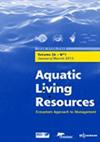群岛海pikepers(Sander lucioperca)的密度和温度依赖性生长
IF 1.9
4区 农林科学
Q3 FISHERIES
引用次数: 0
摘要
在群岛海,斑刺鱼(Sander lucioperca)是商业和休闲渔业的重要物种。刺鱼主要用小网眼大小的刺网捕捞,每年的捕捞死亡率很高。这种渔业以及温度或密度对pike鲈鱼生长的可能影响此前尚未进行研究。本研究的第一个假设是温度对生长的影响是正的,而密度对生长的作用是负的。第二个假设是刺网的大小选择性导致快速生长的个体比生长缓慢的个体在更小的年龄被捕获。结果表明,温度对生长有显著的正向影响,这大于年级密度的负向影响,年级密度对生长也有显著影响。刺网选择性造成高达60的差异 同一年龄段内完全招募的年龄组,在6岁以上和9岁以上捕获的pike鲈鱼之间,背部计算的长度为mm。因此,刺网大小选择性引起的Rosa Lee现象导致年轻时从种群中移除生长较快的标本。这可能导致低估实际增长,从而导致渔业管理不善。本文章由计算机程序翻译,如有差异,请以英文原文为准。
Density and temperature dependent growth of pikeperch (Sander lucioperca) in the Archipelago Sea
In the Archipelago Sea, pikeperch (Sander lucioperca) is an important species in both commercial and recreational fisheries. Pikeperch is caught mainly with small mesh size gillnets, and annual fishing mortality is high. The possible effects of such fisheries, as well as temperature or density on pikeperch growth have not been studied earlier. The first hypothesis of this study was that the effect of temperature on growth is positive and that of density is negative. The second hypothesis was that size-selectivity of gillnets causes the fast-growing individuals to be caught at younger ages than the slow-growing ones. The results showed that temperature had a significant positive effect on growth, and this was greater than the negative effect of year-class density, which was also significant. The gillnet selectivity caused a difference of up to 60 mm in back-calculated lengths in the fully recruited age groups within the same year class, between pikeperch caught at age 6+ and age 9+. Thus, the Rosa Lee phenomenon caused by gillnet size-selectivity led to the removal of faster growing specimens from the population at younger ages. This can potentially cause underestimation of real growth, and thus, poor fishery management.
求助全文
通过发布文献求助,成功后即可免费获取论文全文。
去求助
来源期刊

Aquatic Living Resources
农林科学-海洋与淡水生物学
CiteScore
2.30
自引率
0.00%
发文量
10
审稿时长
>24 weeks
期刊介绍:
Aquatic Living Resources publishes original research papers, review articles and propective notes dealing with all exploited (i.e. fished or farmed) living resources in marine, brackish and freshwater environments.
Priority is given to ecosystem-based approaches to the study of fishery and aquaculture social-ecological systems, including biological, ecological, economic and social dimensions.
Research on the development of interdisciplinary methods and tools which can usefully support the design, implementation and evaluation of alternative management strategies for fisheries and/or aquaculture systems at different scales is particularly welcome by the journal. This includes the exploration of scenarios and strategies for the conservation of aquatic biodiversity and research relating to the development of integrated assessment approaches aimed at ensuring sustainable and high quality uses of aquatic living resources.
 求助内容:
求助内容: 应助结果提醒方式:
应助结果提醒方式:


